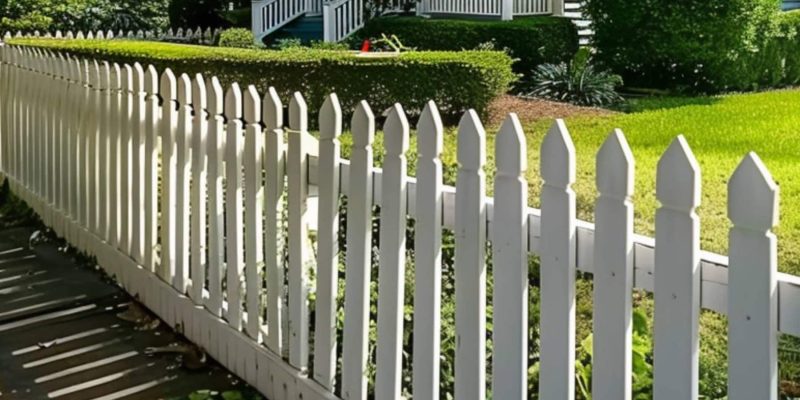Are you thinking about putting up a fence but not quite sure about all the details regarding property lines? Well, you’re in the right spot. Let’s dive into what property lines mean for your fencing project and why they’re so important.
Property Lines: What Are They?
Imagine an invisible line around your property that separates your land from your neighbor’s. That’s your property line. It’s like an outline of your property’s boundary on a map or in real-life terms.
Why Do Property Lines Matter for Fences?
Knowing where your property ends and your neighbor’s begins is crucial before you start digging holes for fence posts. Why? Because building a fence on someone else’s property can lead to disputes, and you might have to take it down or face legal action.
Local laws and homeowner association (HOA) rules play a big part here. They can have specific requirements about how close to the property line you can build your fence. Sometimes, they even have rules about the type of fence you can install.
Understanding your property lines and the related laws ensures your fence project goes smoothly, without upsetting the neighbors or breaking any rules. So, before you grab that shovel or call in the fencing pros, let’s make sure you’re all set with the basics. This knowledge will save you time, money, and possibly a headache down the road.
Can a Fence Be on the Property Line?
Now that we’ve covered what property lines are, let’s tackle a common question: Can you actually build a fence right on the property line? The short answer is, it depends.
General Rules and Local Laws
In many places, yes, you can build a fence on the property line. But, and this is a big but, you usually need your neighbor’s okay to do it. Why? Because when a fence is on the property line, it’s considered a boundary fence, which means it’s owned by both properties it touches.
Local laws and HOA rules can have their say. They might require fences to be set back a little from the property line. These setbacks can vary, so it’s essential to check the specifics for your area. Sometimes, they’re as little as a couple of inches; other times, they could be more.
Importance of Neighbor’s Consent
Getting your neighbor’s consent isn’t just a legal formality—it’s also the neighborly thing to do. Agreeing on the fence’s placement, type, and who’s going to maintain it can prevent disputes down the line. If both parties are contributing to the cost, it’s even more crucial to have everything clear and agreed upon from the start.
Even with your neighbor’s blessing, you still need to follow local building codes and possibly get a permit…
Remember, even with your neighbor’s blessing, you still need to follow local building codes and possibly get a permit before you start building your fence.
Dos and Don’ts of Fence Installation on Property Lines
When it comes to putting up a fence near or on your property line, there are some key dos and don’ts to keep in mind:
Dos
- Check Local Zoning Laws and HOA Rules: Before anything else, find out what’s allowed in your area. This can save you a lot of trouble.
- Talk to Your Neighbors: A simple conversation can go a long way. Discuss your plans and see if you can come to an agreement.
- Consider a Surveyor: If there’s any doubt about where the property line is, hiring a professional surveyor can clear things up. It’s an extra cost but can prevent disputes.
Don’ts
- Ignore Regulations: Skipping the step of checking local regulations or not getting a necessary permit can lead to fines or having to redo your fence.
- Install Without Consent: If the fence will be on the property line, don’t proceed without your neighbor’s go-ahead.
- Forget Future Disputes: Even if things are friendly now, consider how a fence might affect your relationship with your neighbor and potential property access issues in the future.
By sticking to these guidelines, you’ll be on your way to a successful fencing project that respects both legal boundaries and good neighborly relations.
Property Line Disputes: Common Causes and Resolutions
Disputes over property lines are more common than you might think, and they can spring from misunderstandings or unclear property boundaries. Here are a few ways to handle them:
- Communication: Start with a friendly conversation. Sometimes, a simple chat can resolve misunderstandings.
- Documentation: Have your property surveyed and share the documented boundaries with your neighbor. Seeing official records can often settle disputes.
- Mediation: If you can’t reach an agreement, consider mediation. A neutral third party can help you and your neighbor find a compromise.
Fencing Materials and Neighbor’s Rights
The materials you choose for your fence and the rights of your neighbors are also important. Here are some key points:
- Material Considerations: Certain materials might be required or banned by local laws or HOA rules. Plus, some materials might affect your relationship with your neighbors due to aesthetics, durability, or maintenance needs.
- Neighbor’s Rights: If your fence is on the property line, your neighbor might have rights regarding the fence’s appearance and maintenance. Understanding and respecting these rights can prevent legal issues.
Maintenance and Repair Responsibilities
Who takes care of a boundary fence? If the fence is on the property line, maintenance and repair responsibilities might be shared. Here’s how to handle it:
- Agreements: It’s best to agree in advance on how maintenance and repairs will be handled. This agreement can be informal, but writing it down is smarter.
- Local Laws: Some areas have specific laws about shared fences, dictating how costs for repairs and maintenance are divided. Be sure to know these laws to avoid conflicts.
Common Issues Homeowners Face
Fencing can bring up a variety of issues for homeowners. Understanding these can prepare you to deal with them effectively.
Encroachments and Easements
Encroachments occur when a fence extends onto a neighbor’s property. Easements are rights to use someone’s property for a specific purpose, like a driveway or utility line, which can affect where you can build your fence.
- Handling Encroachments: If your fence encroaches on your neighbor’s land, you may need to move it. It’s crucial to resolve this amicably or through legal advice.
- Navigating Easements: Check for any easements on your property before building. Easements can restrict where you can place your fence.
Spite Fences
A spite fence is built not for privacy or security but to annoy a neighbor. These are usually excessively tall and unsightly.
RECOMMENDATION
Many areas have laws against spite fences. Building one can lead to legal action against you, so it’s wise to avoid this route.
Visibility and Safety Concerns
Fences can block sightlines, affecting safety, especially near driveways and corners. Most areas have height regulations for fences, especially in front yards, to maintain visibility for drivers and pedestrians.
Frequently Asked Questions
Got more questions? Here are answers to some common ones:
How close can I legally install a fence to the property line?
It varies by location, so check local laws and HOA rules. Often, you can build right on the line with your neighbor’s consent.
What should I do if my neighbor’s fence is on my property?
Talk to them first. If that doesn’t resolve it, consult a surveyor to confirm the boundary and consider legal advice.
Can I ask my neighbor to share the cost of a boundary fence?
Yes, but they’re only obligated to contribute if local laws or agreements require it.
How do I find out where my property lines are?
Check your property deed or hire a professional surveyor for precise measurements.
What are my options if I disagree with a neighbor over a fence?
Try to resolve it through discussion, mediation, or, as a last resort, legal action.
Tips for a Smooth Fencing Project
Embarking on a fencing project can be a significant undertaking. Here are some tips to ensure everything goes smoothly, fostering good relations with your neighbors and ensuring your fence is up to code.
Planning is Key
- Research Thoroughly: Before you do anything, make sure you understand the local zoning laws, HOA regulations, and any permit requirements in Georgia. This knowledge will guide your project and help avoid legal issues.
- Consider Your Needs: Think about why you’re installing a fence (privacy, security, aesthetics) and let that guide your decisions on materials, height, and design.
Communicate with Your Neighbors
- Early Conversations: Talk to your neighbors about your plans. Early communication can prevent misunderstandings and foster goodwill.
- Share Plans: If the fence will affect their property in any way, sharing your plans can help address any concerns they might have upfront.
Hiring Professionals
- Choose Wisely: If you decide to hire a professional for the installation, choose a reputable contractor with experience in local projects. They can navigate regulations more easily and ensure a quality build.
- Surveying: For boundary fences, hiring a surveyor to mark your property lines accurately can prevent disputes with neighbors.
Prepare for the Future
- Maintenance Agreement: If you’re sharing a fence with a neighbor, consider establishing a maintenance agreement. It can outline responsibilities for repairs, painting, or replacement, preventing future conflicts.
- Consider Access: Ensure that your fence doesn’t block access to any shared resources or necessary easements.
Document Everything
- Keep Records: From permits to agreements with neighbors, keeping a record of all documents related to your fencing project is wise. These documents can be invaluable in case of future disputes or questions.
Conclusion
Installing a fence around your property can enhance your home’s privacy, security, and aesthetic appeal. However, it’s essential to approach the project with careful planning, clear communication, and a thorough understanding of local regulations and property lines. Remember, the goal is to achieve your fencing needs while maintaining a harmonious relationship with your neighbors and adhering to all legal requirements. Good luck with your fencing project, and remember, a little preparation goes a long way in ensuring a smooth process and a beautiful outcome for your home.

